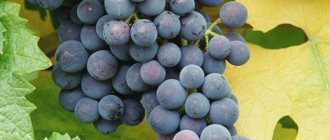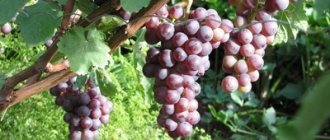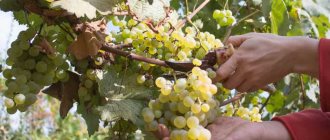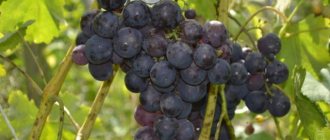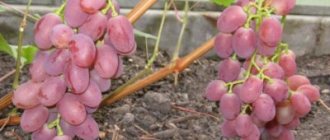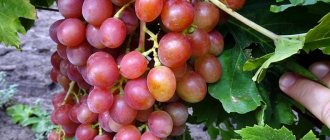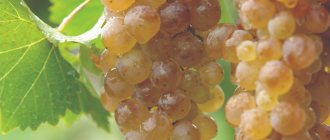Origin
“Triumph” is a table grape variety of American origin. As a parent pair, US breeder J. Campbell used the Concord and Chasselas nutmeg varieties. The resulting “triumph” has all the advantages of its ancestors and has virtually no disadvantages. It is worth noting other varieties of US selection, such as “Cardinal”, “Century” and “Jupiter”.
Parents of “triumph” are “concord” and “chasselas nutmeg”
Reference! Thanks to its good varietal characteristics, “triumph” is actively used to create new hybrid forms.
The survival rate of rootstocks is maximum.
Grapes "Triumph": photo, description of the variety, reviews, features of planting and care
The standard recommendations of agronomists for planting grapes are also suitable for growing the hybrid form “Triumph” in personal plots.
- The best time for planting is considered to be early spring, but planting can also be done in the autumn. When planted in spring, fruiting occurs earlier, and autumn planting shifts fruiting by a season.
- Grapes grow and develop better in southern areas, so it is recommended to plant the plant on the southern wall of a residential or utility building.
- Grape seedlings can be planted either in trenches or in special planting holes.
- Grafted grape seedlings should be planted so that the grafting site is above ground level.
- Vegetating grape seedlings are planted only in the spring, after the first few leaves appear on the bushes.
- Before planting grapes, you should carefully inspect the seedlings, and be sure to remove all damaged roots located above the pair of lower nodes.
- It is advisable to place the rows of the vineyard in the direction from north to south, which will allow for more uniform illumination of the plants. Planting is allowed on slopes steeper than five degrees.
- The planting trench or hole should be equipped with high-quality drainage and two-thirds filled with nutritious soil with the addition of mineral fertilizers.
- After planting, the plants should be watered generously and secured to a support. Mulching the soil around planted grape bushes gives a good result.
Main characteristics
“Triumph” is one of the best varieties bred in America.
Ripening period
The hybrid form of the “triumph” grape is very early in terms of fruit ripening. From the beginning of the growing season until harvest, about 105-110 days pass. By the end of July - beginning of August, you can already enjoy the sweet berries of this grape.
Bush
The bushes have a very strong growth force. The vine ripens almost completely - 95%. The leaves are quite large, three-lobed, slightly dissected. A slight pubescence can be seen on the underside of the leaf. The flowers are bisexual, so no additional pollination is required.
During the season, the vine grows up to 3 meters in length and forms many stepsons. Thanks to its very tall bushes, “triumph” is used to decorate gazebos, arches, walls of houses and other buildings. The productivity of the bushes is very high. From 1 hectare of mature vineyard you can harvest up to 50 tons of grapes.
Bunches and berries
Closer to August, “triumph” ripens in large clusters with a dense structure. The volume of the brush is average. Their weight usually ranges from 600 grams to 1 kg. The shape of the bunch is conical or cylindrical; sometimes there are clusters with one wing.
Reference! In the first year of fruiting, seedlings produce small clusters. But as the vines mature, the clusters greatly increase in size.
“Triumph” is a unique variety not only in its yield, but also in other characteristics. From two parent varieties, Campbell managed to develop a variety with the same properties, but berries of different color. “Triumph” comes in white, light green, golden yellow and dark purple.
The color of the thin skin is uniform and has a slight waxy coating. The pulp is very juicy. The berries are oval-shaped and medium to large in size. Their average weight is 3-6 grams. Sugar content up to 22%. Acidity - 7 g/l.
Taste
High sugar content has a positive effect on the taste of grapes. The taste is pleasant, marmalade, does not contain sourness. It has a pineapple sweetness to it.
Advantages of the variety
The grape called “Triumph” is considered one of the best bred by American breeders, and has a fairly large number of positive properties:
- productivity for the entire growing season is from average to high;
- good growth vigor;
- unpretentiousness and winter hardiness;
- dining appointment;
- weighty berries and bunches;
- marketable appearance of the crop;
- good taste;
- Labrusca taste.
When cultivating this hybrid form, it should be remembered that it is not resistant enough to damage by major grape diseases.
Comparison with analogues
The Amur grape varieties can be compared with the American “triumph”. These uncovered and super-hybrid forms, with large, tasty berries, appeared and became available for cultivation by gardeners throughout Russia thanks to the work of the domestic breeder Alexander Potapenko.
| Sign | Variety | |||
| Triumph | Amur breakthrough (One) | Marinovsky | Amethyst | |
| Ripening period | 105-110 days | 110-115 days | 125-130 days | 90-110 days |
| Frost resistance | up to -40С | up to -40С | up to -32C | up to -35C |
| Yield per bush | up to 50 kg | up to 100 kg | up to 100 kg | up to 50 kg |
| Bunches | 0.6-1 kg | 0.6-1 kg | 0.28-0.5 kg | 0.3-0.7 kg |
| Taste | marmalade | sweet with slight sourness | harmonious sweet and sour | sweet and sour, light nutmeg |
| Color | white, light green, golden yellow or dark purple | from dark crimson to dark purple | rich dark blue to black | dark pink |
| Disease resistance | average | high | high | high |
| Shelf life | 3-6 months | 3-6 months | up to 3 months | up to 3 months |
| Sugar content | 22% | 20-22% | 19-21% | 16-23 % |
| Acidity | 7 g/l | 7-8 g/l | 4-5 g/l | 5-7 g/ |
Choosing a landing site
I inherited the love of gardening from my grandmother. Before retirement, I grew mainly trees and shrubs that did not require much care. And after retiring, I decided to try planting species exotic for our climate.
I was very interested in the Triumph grapes. Of course, I read the description of this variety and saw the photo, but the photo may be retouched, and reviews do not always tell the truth.
However, I was seduced by the phrase early ripening and made up my mind. I can tell the skeptics that the experiment was a success. The harvest has already been collected. The berries are juicy, large and very tasty.
Triumph grapes are a unique variety of table fruit, which is distinguished by its unique taste and a number of features in its care. It was bred in the United States of America by breeder Campbell. It was possible to create this variety by crossing Concord and Muscat Chasly.
The grape variety has clusters of elongated or conical shape. They often reach average volumes compared to other varieties. The berries are similar in shape to an oval. Most often they are large, but sometimes medium ones are also found. The color is golden white or yellow.
- Purpose: dining room;
- Bunch shape: conical, cylindrical-conical;
- Bunch weight: up to 1 kg;
- Berry color: dark purple with a slight waxy coating;
Among the main characteristics that a gardener relies on when choosing a plant, it is worth highlighting the following:
- Short ripening period and rich harvest. Fruit harvesting is recommended in August. The crop yield is gradually increasing. The average volume per hectare of land is fifty tons;
- Frost resistance and disease resistance. It is able to successfully withstand a drop in air temperature of forty degrees. But, it cannot withstand mildew and phylloxera;
- The color of the berries is white, pale green and dark purple. They often reach medium dimensions and above. The shape of the fruit is oval. The weight of the berries is no more than six grams;
- The volume of the brush is close to average. The average weight of a bunch is one kilogram;
- Contains a high percentage of sugar, which has a positive effect on the taste. Sugar content no more than twenty-two percent.
Characteristics
The Triumph grape variety has the following characteristics:
- ripening period and yield - end of August; with age, grape yield increases and reaches 50 t/ha;
- resistance to frost and disease - can withstand temperatures down to -40 degrees; weakly resistant to phylloxera, mildew;
- color, shape and size of berries: white, pale green, golden yellow, dark purple. They reach medium and large sizes, the shape is oval. The weight of the berries reaches 3-6 grams;
- the shape and size of the brush are medium, large, long, the weight of the bunch reaches 1 kilogram;
- taste characteristics – contains a large amount of sugar.
Peculiarities
- This variety begins the growing season earlier than others and, therefore, the fruits begin to ripen faster.
- The Triumph grape variety has bisexual flowers.
- No bush pruning or volume adjustment required.
- By winter, most of the vine dies off, so the bush is small in size.
- Due to the early growing season in spring, grape bushes are subject to spring frosts, but quickly recover. This fact does not harm the subsequent harvest.
grape berries
The variety is distinguished by its abundant harvest and excellent taste.
Belongs to the table variety. Due to the large amount of sugar, sweet and semi-sweet wines, as well as grape juice, are made from it.
- Bunches of grapes have an elongated or conical shape.
- Young seedlings in the first year of fruiting do not produce very large clusters. But every year, as the bush grows, the bunch becomes much larger.
- The berry is medium or large in size, oval in shape.
- Yellow-golden almost white.
- The skin on the berries is thin and smooth.
- The pulp is juicy and sweet.
- The Triumph grape variety is often used to develop new hybrid varieties.
It is in great demand among gardeners because of its rapidly growing vines. They serve both as decoration for the facade and for picking berries. This variety is also famous for its medicinal properties.
Productivity
Triumph, according to experienced winegrowers, always pleases with a rich harvest. Can bear fruit in any climatic conditions. Bunches of grapes under good conditions and proper care reach up to 2 kilograms. At least four brushes are formed on each branch.
Crop productivity is the main quality that interests experienced gardeners when purchasing seedlings. Calculating the yield from one bush is not an entirely accurate indicator.
Each bush can develop differently, especially in the first year of planting.
The climatic conditions of the region in which this species grows should also be taken into account. If the plant comes from the south, then in a colder climate, it will develop differently. Therefore, when choosing seedlings, it is necessary to take this into account. The full harvest takes place at the end of August.
Choosing a landing site
The technology of planting "Triumph" is no different from the technology of planting other varieties. Below is a description of how to do it correctly.
Bushes can be planted in trenches or planting holes. If the seedlings have grafts, they should be placed so that these treated areas rise above the ground. Before planting, grapes must be inspected for damaged roots. If there are any, remove them. You need to add mineral fertilizers and nutrient soil to the hole.
To ensure that the bushes are illuminated evenly, they should be placed from north to south. It is undesirable to plant grapes on slopes whose steepness is more than 5 degrees.
After planting, water the plants and secure them with a support. For greater effectiveness, you should sprinkle the soil near the bush with mulch.
Landing rules
The standard recommendations of agronomists for planting grapes are also suitable for growing the hybrid form “Triumph” in personal plots.
- The best time for planting is considered to be early spring, but planting can also be done in the autumn. When planted in spring, fruiting occurs earlier, and autumn planting shifts fruiting by a season.
- Grapes grow and develop better in southern areas, so it is recommended to plant the plant on the southern wall of a residential or utility building.
- Grape seedlings can be planted either in trenches or in special planting holes.
- Grafted grape seedlings should be planted so that the grafting site is above ground level.
- Vegetating grape seedlings are planted only in the spring, after the first few leaves appear on the bushes.
- Before planting Triumph grapes, all damaged roots located above the pair of lower nodes should be removed.
- It is advisable to place the rows of the vineyard in the direction from north to south, which will allow for more uniform illumination of the plants.
- Planting is allowed on slopes steeper than five degrees.
- The planting trench or hole should be equipped with high-quality drainage and two-thirds filled with nutritious soil with the addition of mineral fertilizers.
- After planting, the plants should be watered generously and secured to a support.
- Mulching the soil around planted grape bushes gives a good result.
- Watering. Regular moistening of the surrounding soil will significantly increase the yield. A good result can be achieved by a drip irrigation system, with its help the necessary substances are transported with water. The beginning of fruit ripening is a reason to stop watering;
- Trimming. It is recommended to trim the arrows of the plant at five eyes. This will preserve the plant culture. Timely sanitary pruning eliminates the possibility of diseases. Affected stems are disposed of after this procedure;
- Treatment. To reduce the likelihood of parasitic organisms appearing, it is necessary to regularly treat the vineyard with antiseptic agents. The description of the Triumph grape variety presented today will allow you to get a decent harvest and avoid the costs of treating and restoring disease-affected bushes.
Features of care
Triumph grapes are a very flexible plant with a high survival rate, but yield indicators largely depend on compliance with growing technology.
Amateur winegrowers are very actively introducing the use of a drip irrigation system in their vineyards, which allows for fertigation, or the application of fertilizers with irrigation water.
At the stage of coloring the berries, irrigation measures must be reduced, and starting from the technical ripening phase of the grapes, watering should be stopped completely. It is recommended to prune the fruit shoots fairly short, by 4-6 eyes. Without pruning, grapes of this variety quickly run wild.
Green pruning of the vineyard is carried out mainly for sanitary purposes. After the procedure, you should lay the entire vine on the ground and pin it.
The bushes should be sprayed with special insecticides and fungicides in order to protect against pests and major grape diseases.
Care instructions
Despite the fact that Triumph is easy to care for, auxiliary procedures should not be neglected. A description of the necessary measures is presented below:
Despite good frost tolerance, young seedlings need to be accustomed to low temperatures gradually. The vineyard should be covered in the traditional way for two years.
For the third winter, you need to leave one sleeve on the support.
Thanks to the ability to quickly adapt to harsh winters and unpretentiousness, Triumph grapes are suitable for cultivation in both southern and northern regions. Caring for the plant is not difficult.
- The best time for planting is considered to be early spring, but planting can also be done in the autumn. When planted in spring, fruiting occurs earlier, and autumn planting shifts fruiting by a season.
- Grapes grow and develop better in southern areas, so it is recommended to plant the plant on the southern wall of a residential or utility building.
- Grape seedlings can be planted either in trenches or in special planting holes.
- Grafted grape seedlings should be planted so that the grafting site is above ground level.
- Vegetating grape seedlings are planted only in the spring, after the first few leaves appear on the bushes.
- Before planting grapes, you should carefully inspect the seedlings, and be sure to remove all damaged roots located above the pair of lower nodes.
- It is advisable to place the rows of the vineyard in the direction from north to south, which will allow for more uniform illumination of the plants. Planting is allowed on slopes steeper than five degrees.
- The planting trench or hole should be equipped with high-quality drainage and two-thirds filled with nutritious soil with the addition of mineral fertilizers.
- After planting, the plants should be watered generously and secured to a support. Mulching the soil around planted grape bushes gives a good result.
Landing rules
Where is this hybrid used?
Juicy and sweet “triumph” berries are consumed fresh and juices are prepared. The large amount of sugars that the berries of this table variety accumulate over the season allows it to be made into excellent sweet and semi-sweet homemade wine. The dessert wine drink has an unusually pleasant and sweet taste.
Advantages and disadvantages
The Triumph grape variety has a number of advantages. These include significant frost resistance, unpretentiousness, a very short time before the first berries appear, high growth intensity, and a bountiful harvest. This variety is widely used to obtain new varieties. The survival rate is pretty good. Damaged parts are regenerated very quickly. This variety is optimal for making wine due to its content of significant amounts of sugar and water.
The disadvantages of the variety include its weak resistance to mildew and phylloxera.
Features of cultivation
“Triumph” is a very unpretentious hybrid. Planting and caring for it is no different from growing other varieties. To get a good harvest of this variety, it is necessary to perform the agrotechnical practices that the grapes require.
The best time for planting is early spring. Then, already in the next season, a two-year-old plant can bring you your first harvest.
Place and soil
Like other grape varieties, “triumph” loves sunlight. Therefore, when choosing a place for planting, you need to focus on southern and well-lit areas of the garden plot. Grapes grow poorly in lowlands and marshy soils.
Recommendations for planting:
- Before planting, inspect the seedlings. If there are damaged areas, be sure to remove them. You can also trim the roots a few centimeters.
- Dig a hole or trench 80 cm deep and wide.
- Place organic fertilizer (manure with straw or compost) at the bottom of the hole.
- Place the seedling in the hole, straighten its roots and cover it with soil.
- Water the soil under the plant well.
Watering and fertilizing
Triumph grapes love watering. With regular soil moisture, the yield increases almost 2 times, compared with rare watering. To retain moisture longer, the soil under the bushes is mulched. Sawdust, hay, straw, pine needles and other organic and synthetic materials are used as mulch.
For irrigation, it is convenient to use drip irrigation systems or through drainage pipes dug into the ground. By automating irrigation in this way, working with the vineyard is greatly simplified.
From the moment the buds appear on the vine, watering should be stopped. Excessive moisture during this period will cause flowers to fall off. After flowering, watering is resumed until the berries become softer. For ripening berries, excess moisture is also harmful; they may begin to crack.
Reference! If fertilizer is added at the time of planting, the plant will not require additional feeding for several years.
Trimming
The shoots of “triumph” grow quickly, becoming long and powerful in one season. To preserve the grape culture and prevent it from going wild, the “triumph” is regularly pruned by 4-6 buds.
It is also necessary to remove damaged and diseased branches. Formative and sanitary pruning ensures a voluminous harvest, large berries and good immunity of the vine to diseases.
The peculiarity of “triumph” is that it is able to regenerate damaged areas in the shortest possible time.
Diseases and pests
“Triumph” has weak immunity to the fungal disease – mildew and grape aphid – phylloxera. To protect plants from these diseases, which can destroy the vineyard, it is necessary to regularly carry out preventive spraying of the vines with various preparations.
Treatment with fungicides and insecticides is carried out throughout the season:
- in early spring, treatment is carried out on the bare vine, until the buds open;
- the next one after a while, while the leaves are blooming;
- during the formation of buds;
- during the flowering period;
- during the period of berry formation;
- before wintering, after leaf fall.
Important! If there is a suspicion of a disease during ripening of the berries, the bushes can be treated with contact agents or preparations with a short waiting period. Spray every 2 weeks or after rain.
Preparing for winter
The hybrid form “triumph” tolerates harsh winters well. The vine can withstand frosts down to -40°C. However, it is better to accustom young plants to cold weather gradually. For the first two years, cover the bushes in the classic way: bending them to the ground, covering them with insulation and film. In the third year, leave 1 sleeve of the vine on the support.
If the vineyard successfully survives three winters the next year, you can not cover it and leave it on a trellis.
Harvest storage
The fruits of “triumph” contain a high percentage of sugar, reaching up to 22%. Sugar content and thin but dense skin contribute to excellent transportability and long storage of the crop. In cool, dry rooms, these grapes can last until the New Year holidays.
Cultivation regions
“Triumph” quickly adapts to the harsh weather conditions and low temperatures of the Russian winter. Its high yield does not depend on weather conditions. Therefore, this grape variety is grown in all regions of Russia. It is successfully cultivated by gardeners in the Krasnodar region, Moscow region, Urals, Siberia and the Far East.
Thanks to its excellent frost resistance, the hybrid is loved by many winegrowers, since this feature greatly facilitates the care and processing of vineyards.
Basics of agricultural technology
Although the Triumph grape is not whimsical and easily adapts to a new place, you should not deprive it of attention.
With timely watering, the yield can increase by one and a half to two times. But as soon as the berries begin to stain and change color, you need to water them half as often.
And when the fruits ripen, stop watering completely..
Drip irrigation.
Root watering.
Drip irrigation has become very popular among gardeners, with the help of which the plant receives the necessary amount of moisture. But it also became possible to add fertilizing and fertilizer to the soil with irrigation water. To prevent the grapes from becoming wild over time, they should be cut off by several eyes.
Grape pruning
Green pruning of grapes is also carried out, this is done exclusively for sanitary purposes.
With frequent green pruning, the plant is cleaned and quickly recovers. To protect the vine from various pests and grape diseases, the bushes must be sprayed regularly.
Grape feeding
The plant needs more fertilizer during rapid flowering and when the ovary begins. Fertilizing can be root or foliar. Foliar feeding means little without root feeding. Only together they give a visible, positive result. During the summer period, fertilizing is carried out several times.
- The first feeding is carried out 2.5–3 weeks before flowering. It is best to use organic fertilizers (poultry manure, cow and horse manure). You can add 0.5 cups of wood ash . At the same time, spraying of the bushes is carried out. Add boric acid and sodium humate to a ten-liter bucket of water. When sprayed with this solution, the ovary and flowers fall off less.
- The second feeding is carried out 1.5 - 2 weeks after the color falls. The composition of the feeding is the same as in the first. The second feeding is needed to improve the growth of the berries.
- The third feeding of grapes is done when the berries are almost ripe and soft. Superphosphate - 40 g and potassium sulfate - 20 g .
- The fourth feeding is carried out after picking the berries. This is done to strengthen and heal the vine. The last feeding is diluted in the same way as the third.
Along with root feeding, the vineyard is also sprayed.
Preparing grapes for winter
We place spruce branches under the vine.
Cover the grapes with roofing felt.
When preparing grapes for wintering, it is worth considering the timing of harvest ripening. If the berries ripen by the end of summer, then care will not be much effort.
After harvesting, watering the grapes should be stopped altogether . Except if there is prolonged heat.
Before covering plants for the winter, the roots must be saturated with all useful substances. Before sending the bushes for the winter, they must be pruned for better formation in the next season. The best time for shelter is mid-November, depending on the climate of the region.
If the bushes are pruned too late, the roots may not have time to absorb all the beneficial elements, and this can cause significant harm to the plant. It is not recommended to completely cut off all shoots. Over the winter, the main part of the bush may weaken or die altogether, in which case in the spring young shoots will serve as a replacement.
Photo
Next, check out the photos and reviews about the “triumph” variety.
Productivity
In the sun the berries may burn.
Triumph, according to experienced winegrowers, always pleases with a rich harvest. Can bear fruit in any climatic conditions. Bunches of grapes under good conditions and proper care reach up to 2 kilograms. At least four brushes are formed on each branch.
This variety is also famous for the fact that it easily and quickly takes root in a new planting site. Frost-resistant and does not require special care. The ability to quickly heal damaged areas.
Crop productivity is the main quality that interests experienced gardeners when purchasing seedlings. Calculating the yield from one bush is not an entirely accurate indicator. Each bush can develop differently, especially in the first year of planting.
The climatic conditions of the region in which this species grows should also be taken into account. If the plant comes from the south, then in a colder climate, it will develop differently. Therefore, when choosing seedlings, it is necessary to take this into account. The full harvest takes place at the end of August .
Reviews
I make wine from Triumph. It turns out very sweet and pleasant taste. Oleg Anatolyevich, Barnaul
An excellent frost-resistant variety, it produces an excellent harvest and makes good wine. Irina, Omsk
Care instructions
Despite the fact that Triumph is easy to care for, auxiliary procedures should not be neglected. A description of the necessary measures is presented below:
- Watering. Regular moistening of the surrounding soil will significantly increase the yield. A good result can be achieved by a drip irrigation system, with its help the necessary substances are transported with water. The beginning of fruit ripening is a reason to stop watering;
- Trimming. It is recommended to trim the arrows of the plant at five eyes. This will preserve the plant culture. Timely sanitary pruning eliminates the possibility of diseases. Affected stems are disposed of after this procedure;
- Treatment. To reduce the likelihood of parasitic organisms appearing, it is necessary to regularly treat the vineyard with antiseptic agents. The description of the Triumph grape variety presented today will allow you to get a decent harvest and avoid the costs of treating and restoring disease-affected bushes.

